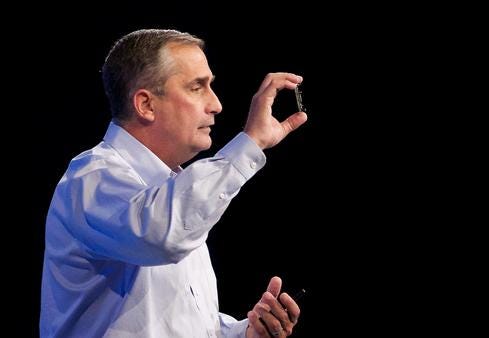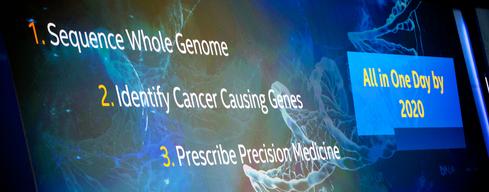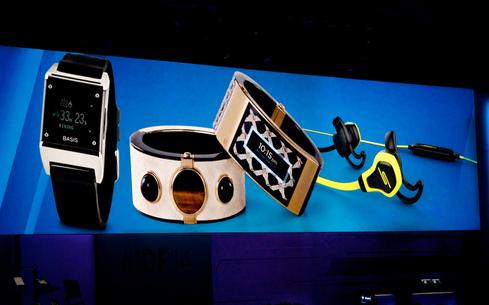Intel Points Wearables, Big Data At Cancer Research
At IDF, Intel execs discuss how an Intel-powered Internet of Things could lead to personalized cancer treatments.


Healthcare IT Cloud Safety: 5 Basics
Healthcare IT Cloud Safety: 5 Basics (Click image for larger view and slideshow.)
At this week's Intel Developer Forum (IDF), CEO Brian Krzanich reiterated his goal, stated last year at the same event, to put "Intel in everything." More powerful and energy-efficient processors for PCs and tablets are a big part of this effort, but Intel's purview has expanded over the last year, branching into new datacenter technologies, big data, wearable devices, and the Internet of Things (IoT).
Krzanich and his colleagues repeatedly characterized these surging tech trends as symbiotic forces. IoT and wearable devices are "very interconnected" because both rely on sensor-equipped objects that send information back to a data center for processing, Krzanich said during a Tuesday keynote. He likened industrial IoT applications to "wearables for machines."
Krzanich said over 2 billion devices currently use Intel chips, but that by 2020, over 50 billion connected devices will be on the market. This possibility raises clear opportunities for Intel: Scores of new devices will need scores of new processors, after all.
Figure 1:  Intel CEO Brian Krzanich holds up his company's IoT-oriented Edison SoC.
Intel CEO Brian Krzanich holds up his company's IoT-oriented Edison SoC.
Moreover, data center chips will need upgrades too, to help manage the exponential increase in traffic these devices will cause. Connected devices "are nothing without the data center," said Intel VP and Data Center Group GM Diane Bryant. She said today's smartphones generate more than 1 trillion daily data center transactions but that wearable devices will be even bigger, encompassing over half the app economy by 2017.
[Do you need a deeper leadership bench? Send your most promising leaders to our InformationWeek Leadership Summit, Sept. 30 in New York City, for a day of peer learning and strategic speakers.]
"Data analytics is the next big technology disruptor," Bryant stated, adding that big data is a "collective opportunity [that will] transform all industries."
Krzanich explained more explicitly why those who pursue this alleged opportunity should include Intel. He said his company's technology ensure all the edge devices slurping up data have a reliable gateway to send information back to a data center.
Figure 3: Intel execs argue that IoT and big data are collective opportunities.
This sort of logic is part prophesy and part sales pitch. It's true that wearable devices and IoT are burgeoning forces, with consumer examples already ranging from connected basketballs to Apple's new smartwatch. It remains debatable how large IoT will become, however, and just how many dumb objects can be made useful with an Intel-flavor makeover (or an Apple-flavored one, for that matter).
Like Cisco and other IoT champions, Intel has launched a variety of efforts to convince partners and the public of IoT's disruptive potential. Bryant highlighted healthcare as "the biggest big data opportunity," both because it involves a lot of data (and will involve even more as wearable devices gain steam), and because the medical industry is relatively open to tech adoption. She also said Intel plans to use IoT and big data to cure diseases, including cancer.
Bryant said the company was working with the Michael J. Fox Foundation on wearable devices that could help doctors and patients better understand Parkinson's Disease. She also said Intel is working with the Knight Cancer Institute to build a cloud that will integrate genomic data, clinical data, and other information into a 1.25-PB system. Intel hopes that number-crunching all of this data will help enable individualized cancer treatments.
"Our objective, by working together, we will sequence a whole genome, and identify the fundamental genes that cause cancer and the means to block them through personalized precision treatment, all in one day, by 2020," Bryant said.
She added that Intel will use what it learns to "create a
blueprint for the industry." She also said Intel has created a curriculum to train oncologists in the use of big data.
Figure 4:  Intel says that by 2020, big data and health-oriented wearable devices will help doctors to create personalized cancer medicines in less than 24 hours.
Intel says that by 2020, big data and health-oriented wearable devices will help doctors to create personalized cancer medicines in less than 24 hours.
Still, healthcare is an obvious target for wearables and big data; after all, Apple and other smartwatch OEMs have all included fitness-tracking functions in their first wearables. But Intel execs detailed broader wearable plans, beyond health applications.
The company announced its Analytics for Wearables (A-Wear) developer program, which lets partners tap Cloudera's Hadoop analytics platform and Intel's cloud. Krzanich and others also reviewed wearable products made by Intel partners. These include SMS Audio BioSport headphones that monitor the wearer's heart rate, an expensive and sketchily defined MICA smart bracelet by Opening Ceremony, and upcoming devices from watchmaker Fossil.
IDF presenters emphasized that wearable devices must fuse looks and functionality. Fossil executive VP and CMO Greg McKelvey, who joined Krzanich onstage during Tuesday's keynote, said his company joined up with Intel because "fashion and tech are impossible to do on your own."
Krzanich said Intel empowers its hardware partners via reference designs for new devices and new low-energy, IoT-oriented chips such as Quark, announced at IDF last year, and Edison, announced in January at CES.
Krzanich said Edison costs only $50 but offers device makers a range of capabilities, including dual-core processing, built-in connectivity, RAM, and expansion options that that include support for Arduino boards. Krzanich said he hopes Intel's open strategy and low-entry costs will engage the "maker" community of enthusiast tinkerers who build devices at home.
Figure 2:  Intel execs say the company's reference designs are helping partners bring wearable devices to market.
Intel execs say the company's reference designs are helping partners bring wearable devices to market.
Krzanich also detailed its City Sense program. Currently deployed in Dublin, London, and San Jose, California, City Sense helps local governments monitor the environment by using sensors to track carbon dioxide, nitrous oxide, and other pollutants. Krzanich and other execs additionally stressed Intel's efforts to create "truly open" standards around IoT that ensure "the devices talk to each other."
Famed physicist Stephen Hawking delivered one of the conference's most affecting IoT pitches in a video played during Tuesday's keynote. Hawking, who is almost entirely paralyzed due to ALS, said Intel has helped to produce a sensor-equipped wheelchair that could dramatically improve quality of life for people with conditions like his. Hawking said the wheelchair demonstrates that IoT is an opportunity to change lives.
In its ninth year, Interop New York (Sept. 29 to Oct. 3) is the premier event for the Northeast IT market. Strongly represented vertical industries include financial services, government, and education. Join more than 5,000 attendees to learn about IT leadership, cloud, collaboration, infrastructure, mobility, risk management and security, and SDN, as well as explore 125 exhibitors' offerings. Register with Discount Code MPIWK to save $200 off Total Access & Conference Passes.
About the Author
You May Also Like






